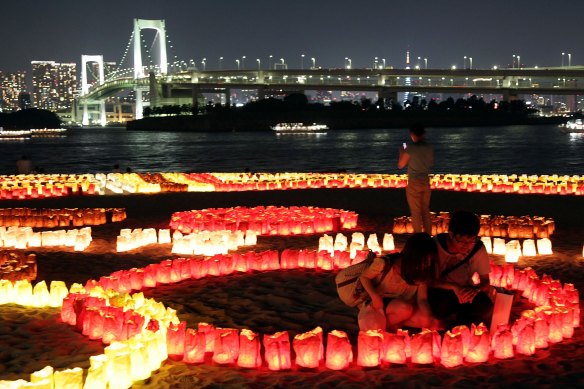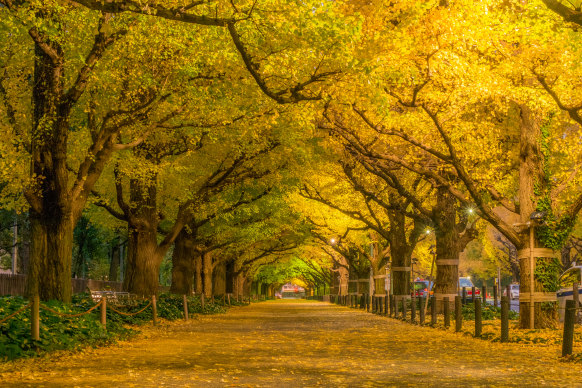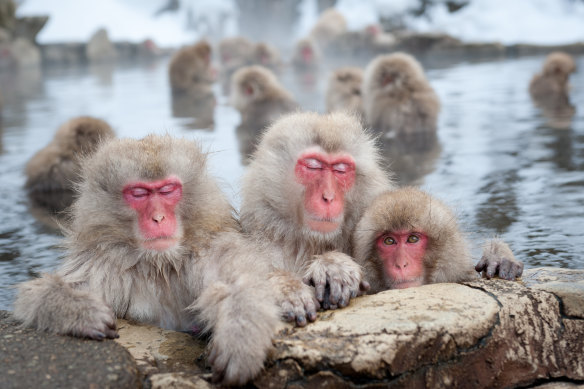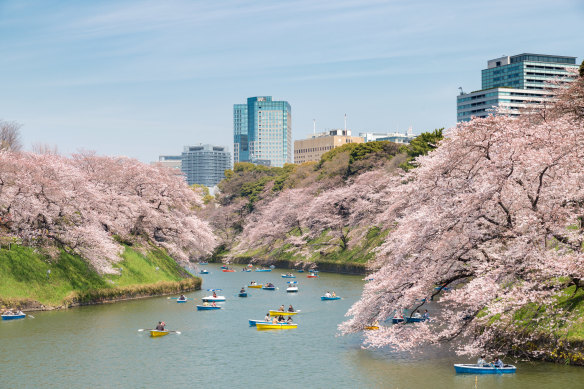There’s always something happening in Tokyo. It doesn’t matter what time of year you turn up, this is a city of almost 40 million people: there is always a festival, or a holiday, or a show or fair or some other exciting event happening.
Still, there are certainly peak and off-peak seasons in the Japanese capital, and some periods offer far more comfort and enjoyment for travellers than others (usually offset by higher prices). If you’re tossing up a trip to Tokyo, this is what you need to consider for each season.
SUMMER

Odaiba’s lantern festival takes place in July.Credit: Getty Images
The weather is mostly hot and humid countrywide in Japan from June to August, and Tokyo is no exception. It gets sticky and uncomfortable here, and that’s something travellers will have to bear in mind. In June and July, it’s normal to have plenty of grey skies and intermittent rain, while August is typically clearer, though also hotter.
However, summer is also peak season for festivals and other events in Tokyo. We’ll discuss them below; suffice to say if you can put up with the weather, you will find plenty to enjoy here in the warmer months.
Don’t miss
Summer in Tokyo is all about fireworks. You will find that many of the key events listed below feature – or are based entirely around – colourful explosions in the sky. Back on solid ground, meanwhile, summer in Tokyo means beer gardens. In the warmer months, you will find these open-air venues popping up all over the city, from rooftops to parks, and even at shrines.
Summer is also firefly season, and there are several locations around Tokyo, including Setagaya ward, and at a popular campground in suburban Hachioji, where people traditionally flock to gaze at these amazing insects.
There’s always seasonal food and drink to enjoy, too. In summer in Tokyo, feast on somen, a cold noodle dish, as well as seasonal cold ramen variations, and the weather is perfect for kakigori – shaved ice with various flavoured toppings.
Key events
Summer is peak season on Tokyo’s matsuri, or festival calendar. Begin with the big hanabi, or fireworks festivals: Sumidagawa on the last weekend in July, the Itabashi Fireworks Festival in August, Jingu-Gaien Fireworks Festival in the same month … the list goes on. In June, check out the 11-day Sanno Matsuri. In July, there are also more traditional festivals such as Mitama Matsuri, and the Lantern Festival in Odaiba.
AUTUMN

Spring’s cherry blossom season gets all the attention, but Japan, and Tokyo, are just as beautiful during autumn.Credit: iStock
The Japanese passion for cherry blossoms is legendary; however, there’s an almost equal appreciation for the country’s colourful autumn foliage. Locals will travel across the country for koyo, or the viewing of autumn leaves. Tokyo has numerous parks and gardens in which to see this foliage, particularly Rikugien, which is spectacular.
That said, the leaves don’t turn until late in autumn. September and October in Tokyo are by far the wettest months, and this is also typhoon season, which means an umbrella and a good raincoat are essential if you’re planning a visit. Temperatures are down though, as are crowd numbers. Still, November offers the best of the season.
Don’t miss
Autumn in Japan is an important time on the sumo calendar. There’s a major meet in Tokyo in September – the Grand Tournament – which is well worth checking out if you’re in town. This is also a time to feast on traditional autumn cuisine, featuring ingredients such as pumpkin, sweet potato, chestnuts, mackerel and anchovies. The first of the winter’s sake batches will also be released.
Key events
September tends to be a little quiet on the events calendar as everyone takes shelter from the rain. Come October, however, the Tokyo International Film Festival begins, plus there’s an autumn festival at Tsukiji fish market, and Halloween is huge, particularly in Shibuya and Shinjuku. In November, watch out for autumn foliage viewing throughout the city’s parks and gardens. The forest town of Nikko, too, is a popular day-trip from Tokyo.
WINTER

Nagano’s famous snow monkeys can be seen on a day trip from Tokyo. Credit: iStock
Australian powderhounds need no introduction to Japan in winter: it’s ski season, and mountain resorts such as Niseko in Hokkaido and Hakuba on Honshu have become firm favourites.
That also means there will be plenty of travellers calling through Tokyo on their way to the mountains, and they will discover a city that is chilly in temperature, but warm in experience.
The weather in Tokyo in winter tends to be crisp and clear, cold but not freezing, with plenty of festivals and events to keep things interesting. New Year’s is huge in Japan, and many workers take a small break around this time, returning to the office around January 4 or 5.
Don’t miss
You can’t ski or snowboard in Tokyo, though with direct shinkansen access to resorts in Nagano and Niigata prefectures, a day-trip to the snow is very much a possibility. You can also get out to Nagano to see the famous snow monkeys in one day.
Back in the capital, winter is also a great time to visit an onsen – a natural hot-spring bath – or a sento, a public bathhouse. Nighttime light shows are big across Tokyo in winter, while viewing plum blossoms – similar to famous cherry blossoms, though not as well known – is also a treat this time of year. On the food front, nabe, the Japanese hotpot, is immensely popular in winter. Snow crab is also in season. And on Christmas Day, the Japanese observe a fairly bizarre new tradition: a trip to KFC.
Key events
In early December, head out to Chichibu, near Tokyo, for a huge fireworks display. As mentioned, New Year’s is huge here, including New Year’s Eve. There are also multiple traditional and religious festivals in January, plus another sumo Grand Tournament meet, before things taper off into a quiet February (which makes this month ideal if you want to beat the crowds and enjoy clear weather).
SPRING

The moat surrounding the parklands of Tokyo’s Imperial Palace is one of the most beautiful places for cherry blossoms in spring.Credit: iStock
In many ways, spring is the ideal season to be in Japan: the weather is cool but not cold, the humidity is low, there’s still snow for skiing, and cherry blossom season sweeps the nation in a floral wave in April and May. The only downside is that everyone else is aware that this is a great time to explore. Tourists pour into the country’s best hanami, or cherry blossom viewing spots, some of which are in Tokyo, and this is also when you’ll run into Golden Week, when most of Japan goes on holiday and hotels book out months in advance.
Don’t miss
Cherry blossom viewing is probably best done in the likes of Kyoto, Hakodate and Hyogo, though Tokyo does have its hotspots, including Ueno Park, Shinjuku Gyoen, and the Imperial Palace Gardens. Even if you’re not enjoying hanami – the act of gathering with friends for the day and enjoying the blossoms, with a little sake for extra enjoyment – spring still has much to offer in Tokyo, including the opportunity to taste seasonal foods such as cherry-blossom mochi, strawberries, and fresh bamboo shoots.
Key events
There are two major matsuri held in Tokyo in May: the Sanja Matsuri, in the Tokyo district of Asakusa, in which more than 2 million spectators gather to watch portable shrines being carried through the streets; and the Kanda Matsuri, a six-day event of parades and other festivities held every odd year. Be aware that Golden Week, in late April to early May, is the most difficult and expensive time to travel in Japan.
Sign up for the Traveller Deals newsletter
Get exclusive travel deals delivered straight to your inbox. Sign up now.